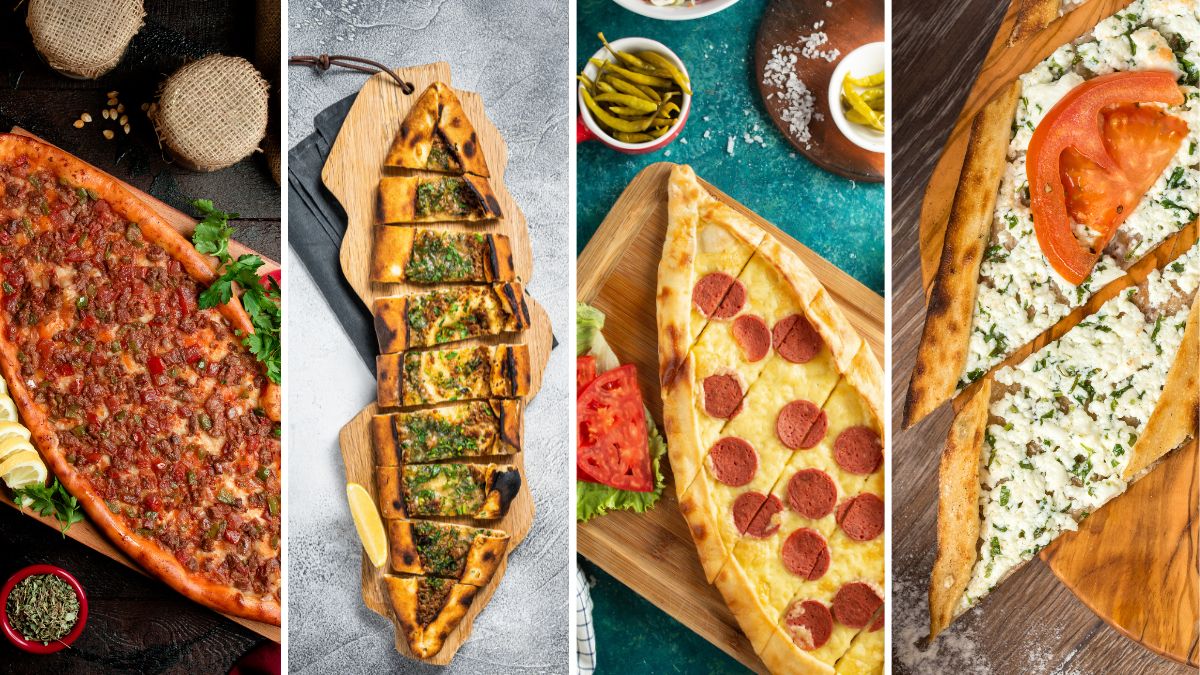Lahmacun vs. Pide: Differences Explained

As your trusted guide to Turkish cuisine, I’m here to help you navigate the ever-changing landscape of delicious traditional dishes. Today, we’re looking at two beloved snacks: lahmacun and pide. Though they share some similarities in ingredients, there are enough differences between them that it can be hard to keep them straight. So, what’s the difference between lahmacun and pide?
Lahmacun is a small thin-crust pizza topped with ground meat, vegetables, and spices, all rolled up and eaten with one’s hands. Pide is larger in size with a thicker crust and can be topped with cheese, vegetables, or meats, cut into slices, and served cold or hot as a main dish.
All in all, lahmacun and pide, though similar, boast distinct flavors and textures that make each a unique culinary experience. So let’s take a deep dive into the deliciousness that is lahmacun and pide and explore the distinct characteristics that make each one unique.
Differences
From the lightly-spiced, savory flavors and crunchy textures of lahmacun to the thicker dough and savoriness of pide, these two dishes are definitely worth exploring. Now let’s look more closely at the key differences between lahmacun and pide.
Dough
The major difference between lahmacun and pide lies in their dough type. Lahmacun is usually made with paper-thin dough, while pide is typically made in a thicker style.
In pide, a traditional boat-shaped dough is flattened with a rolling pin. At the same time, lahmacun is usually rolled out by hand or with a machine to form an oblong oval shape. For both, the dough is typically made from wheat flour and water but may include additives such as milk or yogurt.
Pide dough typically contains eggs and yeast to make it light and airy on the inside but crispy after being cooked in clay ovens. On the other hand, lahmacun dough does not contain any eggs and does not require yeast. This makes for a thinner and chewier consistency, allowing for more toppings without compromising taste.
Though lahmacun would be classified as more of a pizza and pide more of an open-faced wrap sandwich, both make excellent additions to any dinner table!
Shape
As already mentioned, lahmacun is created in a round shape, whereas pide takes on the classic boat shape we are used to seeing in other types of flatbreads.
The difference in shape not only affects the overall look of each type of flatbread but can also affect the cooking time, resulting in a thicker and more dough-like texture for lahmacun, as compared to pide’s thinner and crispier texture.
Depending on your preference and where you are eating it from, one might be more appealing than the other.

Cooking Techniques
Being round allows lahmacun to easily fit onto a baking tray with minimal reshaping needed, and it cooks relatively quickly. The finished product is usually thick and chewy – and oh-so-good!
On the other hand, the pide must be stretched into an oar-shaped form before baking due to its boat shape.
The added baking time helps create a golden brown crust that crackles in your mouth with each bite – best enjoyed dipped into some hummus or any sauce you choose!
Besides, lahmacun is traditionally cooked in a wood-fired oven, similar to a pizza oven, while pide is generally cooked on a stovetop or in the oven.
When it comes to using an oven for both dishes, there are differences too. The oven setting for lahmacun is usually higher than that for pide, and it only takes about five minutes for lahmacun to cook through, whereas pide takes longer than 10–15 minutes.
Toppings
When it comes to toppings, there’s a big difference between lahmacun and pide. The topping on lahmacun is very simple, usually just minced meat and vegetables.
On the other hand, pide toppings tend to be quite elaborate and can range from classic ground beef to feta cheese and spinach or even roasted vegetables! I’ve even tried my hand at making it! Not to brag, but it turned out amazing!
The topping possibilities for pide are truly endless, so you can customize your dish to your heart’s content! The most popular toppings on pide include ground beef, cheese (such as feta cheese or mozzarella), spinach, eggs, tomatoes, onions, olives, mushrooms, or roasted vegetables (such as eggplant, zucchini, and peppers).

Taste and Texture
When it comes to taste and texture, one of the most defining characteristics of lahmacun and pide is their dough. The dough for lahmacun is traditionally a thin and crunchy flatbread, while pide dough is typically thicker, softer, and chewier.
While lahmacun’s topping usually consists of minced beef, lamb, or chicken with various herbs and spices added for more flavor, pide toppings are typically made with larger chunks of ingredients. It can range from a classic combination of minced beef, peppers, onions, and seasonal greens to more luxurious fillings like gorgonzola cheese or shrimp.
Overall, both dishes have their own unique flavors and textures that make them stand out from each other. Whether it’s lahmacun’s thin crust with its savory toppings or pide’s soft bread base with its hearty fillings, you’ll find something to satisfy your taste buds!
